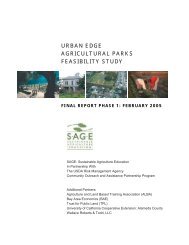A Feasibility Study for Urban Edge Agricultural Parks - SAGE
A Feasibility Study for Urban Edge Agricultural Parks - SAGE
A Feasibility Study for Urban Edge Agricultural Parks - SAGE
Create successful ePaper yourself
Turn your PDF publications into a flip-book with our unique Google optimized e-Paper software.
CHISPA Farm Worker HousingThis model illustrates how af<strong>for</strong>dable housing developers have accessed publicfunding to specifically target homeownership and rental housing opportunities <strong>for</strong>key portions of the agricultural labor <strong>for</strong>ce. Further, it provides insight into thehistoric evolution of strategies from the <strong>for</strong>mation of cooperative homeownershipopportunities to the utilization of tax credit allocations <strong>for</strong> support. Finally, itillustrates that while cooperatives have been a realistic means to createopportunities <strong>for</strong> individual control and preserve af<strong>for</strong>dable housing <strong>for</strong> agriculturalworkers, such models face unique management issues.Background and PurposeCommunity Housing Improvement Systems and Planning Association, Inc.(CHISPA) has developed over fifteen hundred units of housing <strong>for</strong> low-incomehouseholds as the largest private non-profit housing developer in Monterey County.CHISPA is not explicitly mission driven to serve agricultural workers but, as 80 to90 percent of low-income clients work in agricultural industry, it serves thispopulation by default. CHISPA largely inherited cooperative housing projectsserving farm workers, while active in developing additional units to serve theagricultural work<strong>for</strong>ce of Monterey County. This legacy began with the San Jerardocooperative--the first USDA Rural Housing Services (RHS) Agency funded farmworker cooperative. Constructed in 1979, the United Farmworkers had organizedlabor camp residents, previously dislocated, to secure homeownership and controlof a new site. While the farm workers sought unrestricted ownership of theirhomes, the cooperative structure was chosen as a compromise in order to complywith local zoning laws.Though CHISPA has retained management of 40 units in Vista la Terraza, a rentalproject with cooperative management, CHISPA has not developed a cooperativehousing project in recent years. They transferred management of the 75 rentalunits in cooperatively run La Casa Madera, with on-going rental assistance fromHUD under Section 8a and a mix of three and four bedrooms, to the John StewartCompany. CHISPA also developed La Buena Esperanza, a 50 unit cooperativeproject serving farm workers in King City, but the site is no longer under theirmanagement as CHISPA has tried to minimize management of cooperatives. Theirexperience indicates coops are very labor intensive and potentially conflict ridden.Instead the developer has sought ownership and rental housing with support fromState Tax Credit Allocation Commission, which funds af<strong>for</strong>dable housing throughoutthe State and has had targeted allocation to support farm worker housing and theJoe Serna, Jr. Farm worker Housing Grant Program (JSJFWHG).DRAFT 1.6.05 74





